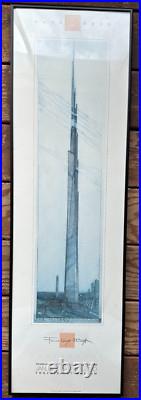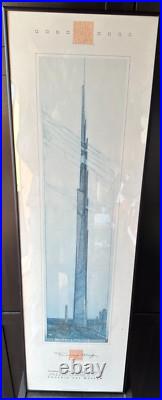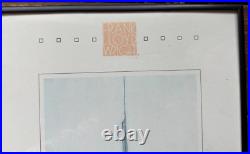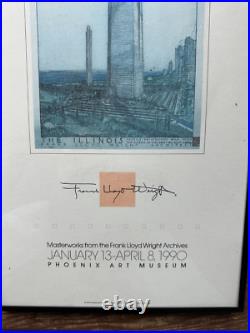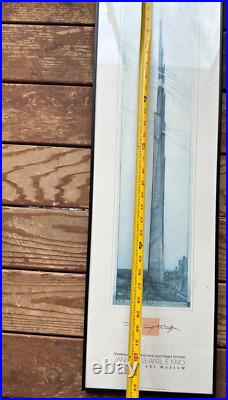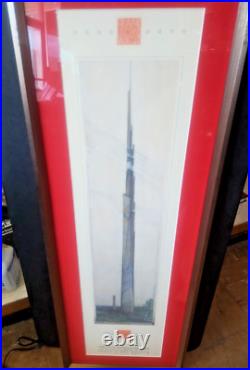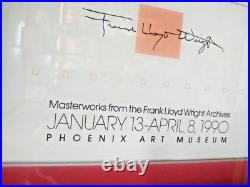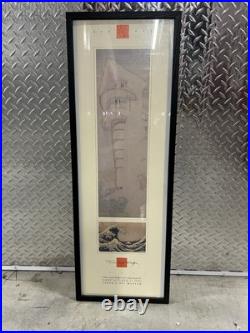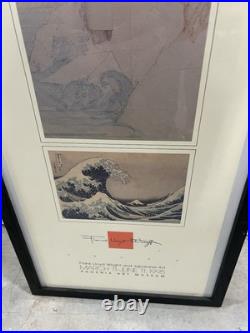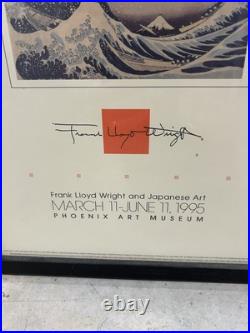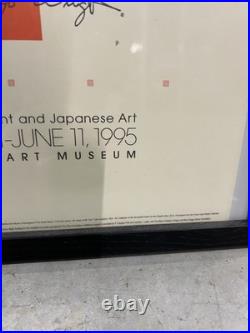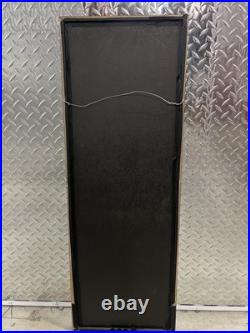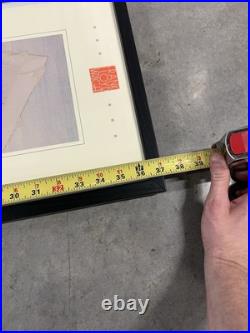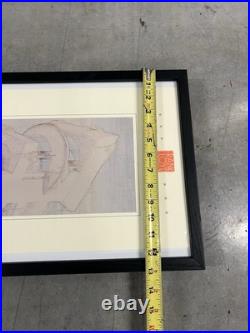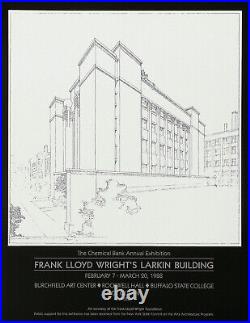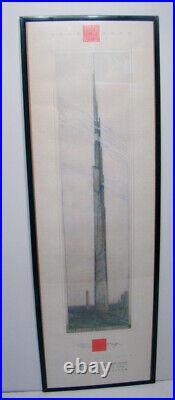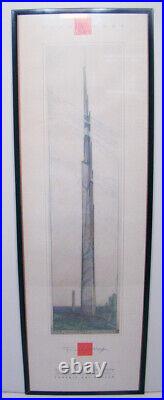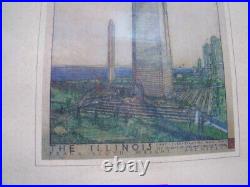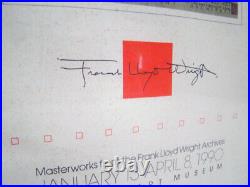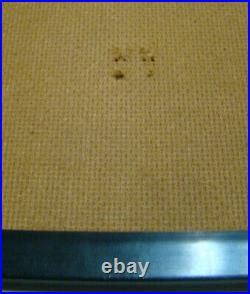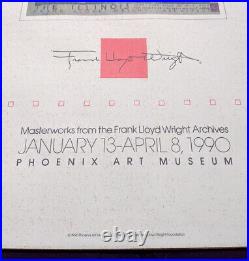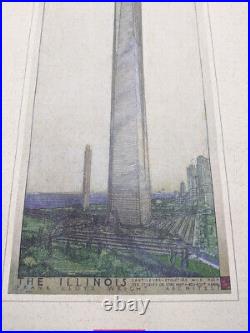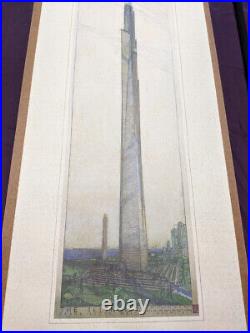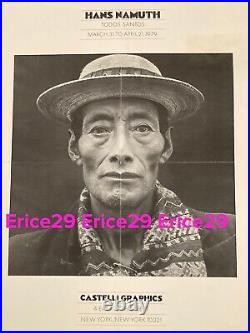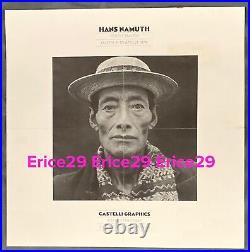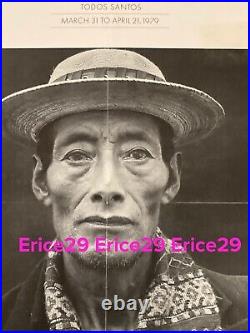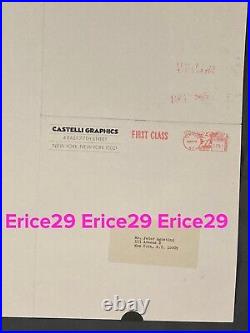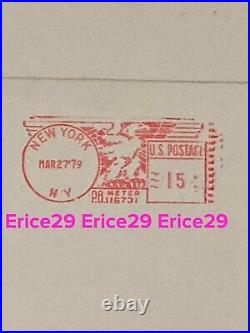Posts tagged exhibition
The product is an original FRANK LLOYD WRIGHT Exhibition Poster from the Phoenix Art Museum, measuring 11″x36″. Produced in 1990, this large poster features a theme of art with a focus on the work of Frank Lloyd Wright. As a 1st Edition piece, this original poster is a unique and collector’s item that showcases the iconic designs and architecture of the renowned designer.
MEIBOHM FINE ARTS, INC. Is pleased to be serving the community and art enthusiasts for over a century. A reputation for personalized attention and customer service is an important part of this family business. Residential and commercial clients benefit from our knowledge of the art world, our experience in quality custom framing and from our extensive inventory. We hope we can be of service to you. We have thousands of Antique, Vintage, Mid Century & Contemporary Prints, Original Artwork, and Etchings etc, that are in our archives, and most of which have not seen the Light-of-Day in over 75+ years or more. From Grace Meibohm & the Staff at Meibohm Fine Arts, Inc. OUR QUALITY & RARITY CODES. QUALITY CODE: Note: Older paintings or original artwork of any kind may be rated somewhat differently based on the codes below, due to the normal aging properties of the different mediums used ex: normal paint cracquelure with older paintings, toning of paper, foxing on older pieces, etc… Museum Quality, with no damage or visible imperfections. Almost perfect given the age w/minimal imperfections, minimal blemishes. Above average w/minor imperfections given the age, or minor blemishes. Average imperfections given the age, or moderate imperfections or wear. Below average with more imperfections given the age, or with more wear. With clear imperfections and/or possibly in need of minor restoration. With clear imperfections and/or possibly in need of serious restoration. Unique, one of a kind, or an original on the open market. Very uncommon and/or very difficult to find on the open market. Uncommon and/or moderately difficult to find on the open market. Frequently encountered, common and easy to find on the open market. All Measurements Are In Inches; Height Precedes Width. Here is a Beautiful & Ultra-Rare Original 1988 OOP (Out-of-Print) Exhibition Lithograph Poster titled, “Frank Lloyd Wright’s Larkin Building”, with additional text,’The Chemical Bank Annual Exhibition’ and the date,’February 7 – March 20, 1988, Burchfield Art Center? Rockwell Hall? Buffalo State College, Jack Quinan Curator’ and’Art Courtesy of the Frank Lloyd Wright Foundation, Public support for this exhibition has been received from the New York State Council on the Arts Architecture Program. , which all appear lower-middle in the bottom outer margin area. Of Buffalo, New York. The Larkin Building was one of two projects Wright designed that year for the famous designer, Darwin D. (Quote from: pbs site). Through Martin, Wright got the job of designing the Larkin Company administration building, the first entirely air-conditioned modern office building on record… It is blocklike and extremely simple in its forms, and has very little ornamentation… The Larkin building was decisively vertical… Indeed, it was the first consciously architectural expression of the kind of American structure which Europeans were beginning to discover to their delight: the great clusters of grain silos and similar industrial monuments that men like Corbu and Gropius found so exciting in the early 1920s… (Excerpts from: Peter Blake, Frank Lloyd Wright: Architecture and Space). Lloyd once said years later of the design, I think I first consciously began to try to beat the box in the Larkin building. I found a natural opening to the liberation I sought when [after a great struggle] I finally pushed the staircase towers out from the corners of the main building, made them into freestanding, individual features. It is interesting that I, an architect supposed to be concerned with the aesthetic sense of the building, should have invented the hung wall for the w. (easier to clean under), and adopted many other innovations like the glass door, steel furniture, air-conditioning and radiant or’gravity heat. Nearly every technological innovation used today was suggested in the Larkin Building in 1904. The Larkin building was an icon of modern architecture with its cutting-edge technology, and unfortunately in 1950, the Building was demolished and is considered a tragic loss for American architecture. The image area with the line drawing of the building is actually printed with a nice silver metallic ink (but does not show up correctly in the photo). The Litho is printed with a full-bleed on all sides and is on a nice smooth medium-weight ivory-colored wove paper stock. Size & Condition: The sheet size is 23-1/4″ x 18″, Image size is 17″ x 16-13/16″ and is in Excellent+ Rare+ condition with absolutely no color fade and is OOP (Out-Of-Print) with the Burchfield-Penney Art Center Museum. No Tears, No Foxing and No Creasing! No damage at all on this gorgeous print-simply beautiful! This exhibition poster has never been framed which is always more desirable to collectors since it has never been exposed to older non-archival materials, matburn or lightfade. PAYING FOR YOUR ITEM. Union, NO International M. & WORLDWIDE (Excludes: China, Korea, South, Russian Federation, Haiti, Hong Kong, Taiwan, Ethiopia, Ghana, Nigeria, Somalia). Our customers have greatly appreciated their well-packed & well-protected artwork as our feedback clearly shows. We have unfortunately been on the receiving end of poorly-packed artwork and we wouldn’t wish that on our worst enemies. Law we are unable to mark a smaller amount or to declare the item a gift, sample, or anything other than merchandise prints/paintings etc, so PLEASE DO NOT ASK. We are a respectable business & must transact our auctions honestly & by the law. We would be liable and would get in trouble if there were any complications. Note: Some Combined Rates may be higher due to Combined Weight changes or Oversized (OS1) dimensions, for items such as: Framed items, multiple paintings on canvas, oversized items etc. We make every effort to pack artwork securely and carefully as per the items’ specifications. BOXES Meibohm Fine Arts, Inc. Meibohm Fine Arts, Inc. We are completely honest with our’Item Descriptions’ (even to a fault) and our customers have appreciated it, as our feedback clearly shows.
Original vintage print from the 1990 Phoenix Art Museum exhibition of Masterworks by Frank Lloyd Wright Archives. Featuring the iconic (never built) Mile High Cantilevered “Illinois Building” that was drawn and proposed by Frank Lloyd Wright for the city of Chicago back in 1956. Overall frame measures 36″ x 11″. I’ve shown it in and out of the frame. Marked across the bottom. This comes as found in an estate. Print has no tears, stains, creases or folds. The plexi has done well in protecting it, but would recommend being re-framed put behind glass with a matt? I’ll leave that to you. T miss out by waiting until the last minute. Once its gone its gone. Please see the photos below for a better understanding of the description. Thank you for stopping by and I look forward to having you as a new customer. Buyers pay 7.75% IL. INTERNATIONALLY ON STORE ITEMS ONLY!
1979 Hans Namuth Todas Santos March 31 to April 21, 1979 Exhibition Poster Leo Castelli Graphics. 4 East 77th Street. New York, New York 10021. Hans Namuth (March 17, 1915 – October 13, 1990) was a German-born photographer. Namuth specialized in portraiture, photographing many artists, including abstract expressionist Jackson Pollock. His photos of Pollock at work in his studio increased Pollock’s fame and recognition and led to a greater understanding of his work and techniques. Namuth used his outgoing personality and persistence to photograph many important artistic figures at work in their studios. Died October 13, 1990 (aged 75). East Hampton, New York, United States. Namuth photographed many other painters such as Willem de Kooning, Robert Rauschenberg, and Mark Rothko and architects such as Frank Lloyd Wright, Philip Johnson, and Louis Kahn. Namuth focused on his rapport with his subjects, getting many reclusive figures such as Clyfford Still to agree to be photographed. Namuth’s work not only captured his subjects in their studios with their works, but also captured the relationship between photographer and subject as well as the subjects’ levels of self-consciousness. Besides famous art figures, Namuth photographed the Mam people of Todos Santos, whose native lifestyles were being overrun by Western influences. Namuth died in a Long Island car crash in 1990. One of Namuth’s many photos of Jackson Pollock painting with his “drip” method. Hans Namuth was not initially interested in the work of Jackson Pollock, but was convinced by his teacher Alexey Brodovitch that Pollock was an important painter. In July 1950, Namuth approached Pollock and asked to photograph the artist working in his studio. Pollock agreed, encouraged by his wife, Lee Krasner, who was aware of the importance of media coverage. The resulting images helped to demystify Pollock’s famous “drip” technique of painting, revealing it to be a deliberative process rather than a random splashing of paint. They “helped transform Pollock from a talented, cranky loner into the first media-driven superstar of American contemporary art, the jeans-clad, chain-smoking poster boy of abstract expressionism, ” according to acclaimed culture critic Ferdinand Protzman. Not satisfied with black and white stills, Namuth wanted to create a color film that managed to focus on Pollock and his painting at the same time, partially because he found more interest in Pollock’s image than in his art. His solution was to have Pollock paint on a large sheet of glass as Namuth filmed from underneath the work. As Namuth could not afford professional lighting, the film was shot outside Pollock’s Long Island home. This documentary (co-produced with Paul Falkenberg) is considered one of the most influential for artists. In November 1950, Namuth and Pollock’s relationship came to an abrupt conclusion. After coming in from the cold-weather shoot of the glass painting, Pollock, who had been treated in the 1930s for alcoholism, poured himself a tumbler of bourbon whiskey after supposedly having been sober for two years. An argument between Namuth and Pollock ensued with each calling the other a “phony”, culminating in Pollock overturning a table of food and dinnerware in front of several guests. From then on, Pollock reverted to a more figure-oriented style of painting, leading some to say that Namuth’s sessions robbed Pollock of his rawness and made Pollock come to feel disingenuous about doing things for the camera that he had originally done spontaneously. Art critic Jonathan Jones suggests that by filming Pollock, Namuth “broke the myth of trance” and by framing Pollock’s work in the larger surrounding landscape, destroyed Pollock’s view that his paintings were boundless. Jeffrey Potter, a close friend of Pollock’s, described Namuth as commanding, frequently telling Pollock when to start and stop painting. According to Potter, Pollock felt what was happening was phony. ” Namuth himself describes Pollock as being “very nervous and very self-conscious of the filming at the time, but less so when Pollock discussed it in a later interview. During his time with Pollock, Hans Namuth had created two films and captured more than 500 photographs of the artist. These photos were first published in 1951 in Portfolio, a journal edited by Alexey Brodovitch and Franz Zachary. After the death of Pollock in 1956, Namuth’s photos grew in popularity and were often used in articles about the painter in place of Pollock’s artwork itself. Art historian Barbara Rose states that the photographs changed art by focusing on the creation of art rather than the final product alone. Younger artists such as Bruce Nauman, Richard Serra, and Robert Morris were able not only to view Pollock’s paintings, but, with Namuth’s images, to see Pollock in the act of painting, giving rise to the popularity of Process Art. These photos have also allowed art historians to dissect the details of Pollock’s method. For example, art historian Pepe Karmel found that Pollock’s painting in Namuth’s first black-and-white film began with several careful drippings forming two humanoid figures and a wolf before being covered beneath several layers of paint.
